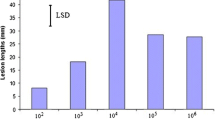Abstract
Development of Clonostachys rosea in rose leaves and petals and control of Botrytis cinerea by the agent were investigated. C. rosea germinated, established endophytic growth, and sporulated abundantly whether the tissues were mature, senescent or dead when inoculated. Germination incidence was moderate on mature and senescent leaves (47% and 35%) and petals (31% and 43%), and high (>98%) on dead tissues. Sporulation of C. rosea in tissues inoculated when mature, senescent or dead averaged 41%, 61%, and 75% in leaves, and 48%, 87% and 53% in petals. When leaves were wounded with needles before inoculation, germination of C. rosea increased from 45–56% to 90–92%, but sporulation became high (> 75%) regardless of wounds. When leaves were inoculated with C. rosea at 0–24 h after wounding and subsequently with B. cinerea, germination of the pathogen was reduced by 25–41% and sporulation by ≥ 99%. A humid period prior to inoculation of senescent or dead leaves promoted communities of indigenous fungi, reduced sporulation of C. rosea and B. cinerea, and, in dead leaves, increased control of the pathogen associated with C. rosea. Applied at high density, isolates of indigenous Penicillium sp. and Alternaria alternata from rose interacted with C. rosea and reduced control of the pathogen by 16% and 21%, respectively. In conclusion, C. rosea markedly suppressed sporulation of B. cinerea in rose leaves and petals regardless of developmental stage, minor wounds, and natural densities of microflora. This versatility should allow C. rosea to effectively control inoculum production of B. cinerea in rose production systems.
Similar content being viewed by others
References
Blakeman JP (1980) Behaviour of conidia on aerial plant surfaces. In: Coley-Smith JR, Verhoeff K and Jarvis WR (eds) The Biology of Botrytis (pp 115–151) Academic Press, London
Elad Y (1988) Latent infection of Botrytis cinerea in rose flowers and combined chemical and physiological control of the disease. Crop Protection 7: 361–366
Elad Y and Evensen K (1995) Physiological aspects of resistance to Botrytis cinerea. Phytopathology 85: 637–643
Elad Y and Volpin H (1991) Heat treatment for the control of rose and carnation grey mould (Botrytis cinerea). Plant Pathology 40: 278–286
Elad Y, Kirshner B and Gotlib Y (1993) Attempts to control Botrytis cinerea on roses by pre-and post-harvest treatments with biological and chemical agents. Crop Protection 12: 69–73
Hammer PE and Evensen KB (1994) Differences between rose cultivars in susceptibility to infection by Botrytis cinerea. Phytopathology 84: 1305–1312
Hammer PE and Marois JJ (1989) Nonchemical methods for post-harvest control of Botrytis cinerea on cut roses. J Amer Soc Hort Sci 114: 100–106
Hausbeck MK and Moorman GW (1996) Managing Botrytis in greenhouse-grown flower crops. Plant Dis 80: 1211–1219
Horst RK (1983) Compendium of Rose Diseases. The American Phytopathological Society, St. Paul, MN, USA
Jarvis WR (1992) Managing Diseases in Greenhouse Crops. The American Phytopathological Society, St. Paul, MN, USA
Köhl J and Fokkema NJ (1998) Strategies for biological control of necrotrophic fungal pathogens. In: Boland GJ and Kuykendall LD (eds) Plant-Microbe Interactions and Biological Control (pp 49–88) M. Dekker Inc., New York
Morandi MAB, Sutton JC and Maffia LA (2000) Relationships of aphid and mite infestations to control of Botrytis cinerea by Clonostachys rosea in rose (Rosa hybrida) leaves. Phytoparasitica 28: 55–64
Peng G and Sutton JC (1991) Evaluation of microorganisms for biocontrol of Botrytis cinerea in strawberry. Can J Plant Pathol 13: 247–257
Redmond JC, Marois JJ and MacDonald JD (1987) Biological control of Botrytis cinerea on roses with epiphytic microorganisms. Plant Dis 71: 799–802
Saha DC, Jackson MA and Johnson-Cicalese C (1988) A rapid staining method for detection of endophytic fungi in turf and forage grasses. Phytopathology 78: 237–239
Schroers HJ, Samuels GJ, Seifert KA and Gams W (1999) Classification of the mycoparasite Gliocladium roseum in Clonostachys as C. rosea, its relationship to Bionectria ochroleuca, and notes on other Gliocladium-like fungi. Mycologia 91: 365–385
Snedecor GW and Cochran WG (1989) Statistical methods. 8th edn. The Iowa State University Press
Sutton JC (1995) Evaluation of microorganisms for biocontrol: Botrytis cinerea and strawberry, a case study. In: Andrews JH and Tommerup I (eds) Advances in Plant Pathology, Vol 11 (pp 173–190) Academic Press, London
Sutton JC, Li D-W, Peng G, Yu H, Zhang P and Valdebenito-Sanhueza RM (1997) Gliocladium roseum, a versatile adversary of Botrytis cinerea in crops. Plant Dis 81: 316–328
Tatagiba JdaS, Maffia LA, Barreto RW, Alfenas AC and Sutton JC (1998) Biological control of Botrytis cinerea in residues and flowers of rose (Rosa hybrida). Phytoparasitica 26: 8–19
Williamson B (1994) Latency and quiescence in survival and success of fungal plant pathogens In: Blakeman JP and Williamson B (eds) Ecology of Plant Pathogens (pp 187–207) CAB International, Wallingford, UK
Yu H and Sutton JC (1997) Morphological development and interactions of Gliocladium roseum and Botrytis cinerea in raspberry. Can J Plant Pathol 19: 237–246
Author information
Authors and Affiliations
Rights and permissions
About this article
Cite this article
Morandi, M.A., Sutton, J.C. & Maffia, L.A. Effects of Host and Microbial Factors on Development of Clonostachys rosea and Control of Botrytis cinerea in Rose. European Journal of Plant Pathology 106, 439–448 (2000). https://doi.org/10.1023/A:1008738513748
Issue Date:
DOI: https://doi.org/10.1023/A:1008738513748




